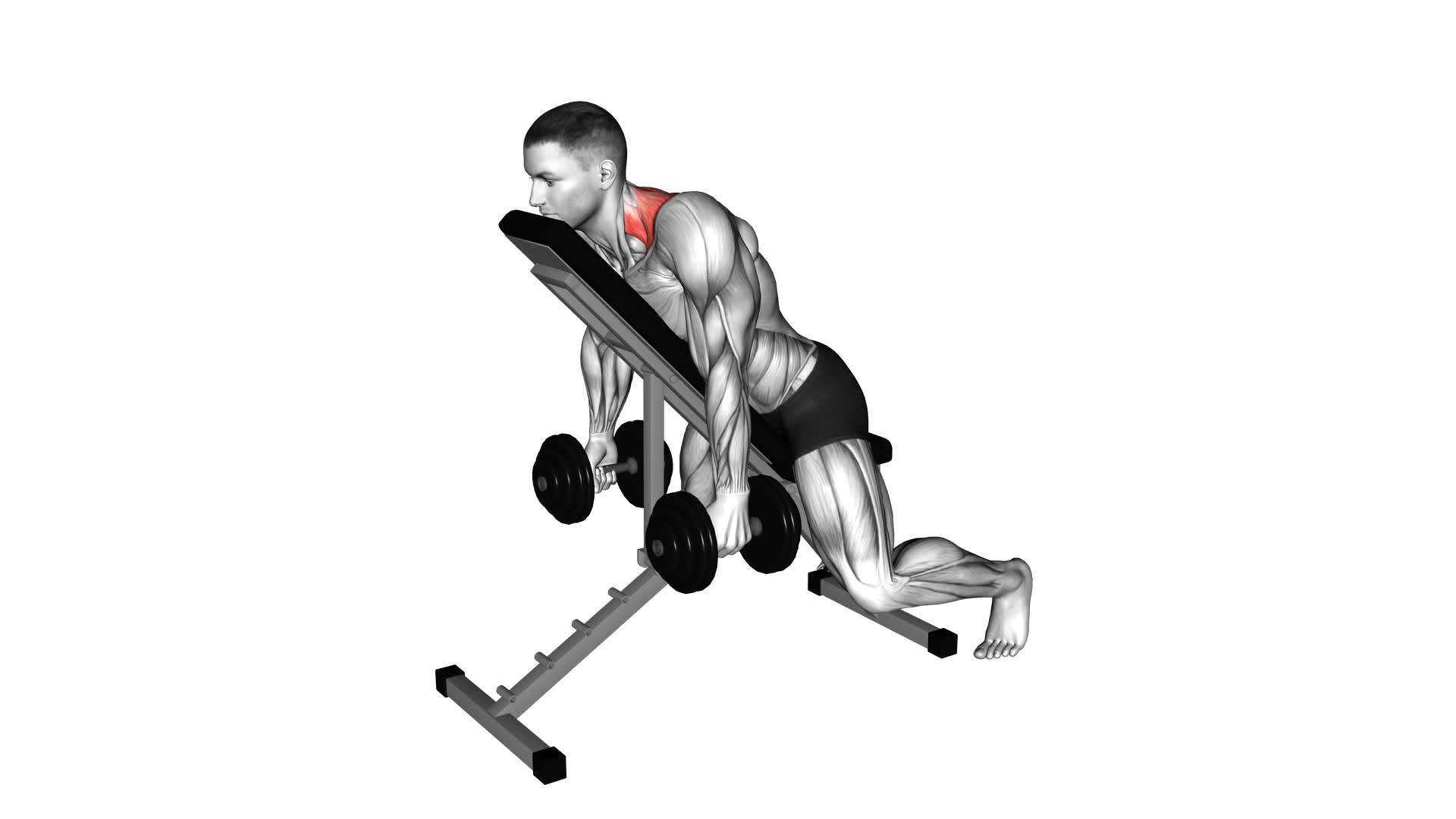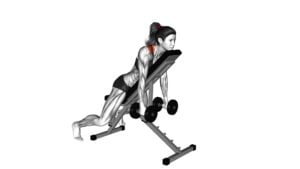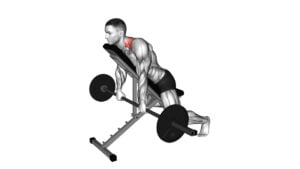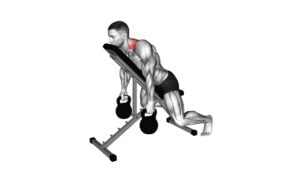Dumbbell Decline Shrug – Video Exercise Guide & Tips

Get the most out of your workout with the Dumbbell Decline Shrug.
Watch This Exercise Video
This exercise targets your trapezius muscles, helping to build strength and definition in your upper back.
In this video exercise guide, you'll learn the proper form and technique for the Dumbbell Decline Shrug, as well as common mistakes to avoid.
With variations and progressions included, you'll be able to challenge yourself and continue to see results.
Watch the video and get started today!
Key Takeaways
- The dumbbell decline shrug targets the trapezius muscles effectively and builds strength and definition in the upper back.
- It engages other supporting muscles such as the rhomboids and deltoids, improving posture and stability.
- Using proper form and technique, including maintaining correct body alignment and a full range of motion, maximizes muscle engagement.
- Variations and modifications, such as using different grips or adding resistance bands, can be used to target different areas of the upper back and challenge the muscles in new ways.
Benefits of the Dumbbell Decline Shrug
Experience the numerous benefits of the Dumbbell Decline Shrug.
This exercise offers a variety of variations that can target different muscle groups and enhance your workout routine. By incorporating dumbbell decline shrug variations, you can challenge your muscles in new ways and prevent plateaus in your training.
One of the key benefits of the dumbbell decline shrug is its ability to target the trapezius muscles effectively. This exercise helps to strengthen and build the upper back, improving posture and stability. Additionally, the dumbbell decline shrug engages the rhomboids, deltoids, and other supporting muscles, resulting in a well-rounded upper body workout.
To maximize the benefits of the dumbbell decline shrug, it's important to focus on proper breathing technique. Inhale deeply before initiating the movement, and exhale forcefully as you lift the dumbbells. This technique helps to stabilize your core and enhance your overall performance.
By incorporating the dumbbell decline shrug into your workout routine, you can experience improved upper body strength, enhanced posture, and increased stability.
Now that you understand the benefits, let's move on to discussing the proper form for the dumbbell decline shrug.
Proper Form for the Dumbbell Decline Shrug
To perform the dumbbell decline shrug with proper form, you need to position yourself on a decline bench with a set of dumbbells. Here are some key points to keep in mind for executing this exercise correctly:
- Start by lying face down on the decline bench, with your feet secured at the end and your head positioned at the top.
- Hold a dumbbell in each hand, with your palms facing your body and your arms extended towards the floor.
- Keeping your arms straight, elevate your shoulders towards your ears as high as possible, squeezing your shoulder blades together at the top of the movement.
- Slowly lower the dumbbells back down to the starting position and repeat for the desired number of repetitions.
Proper form is essential when performing the dumbbell decline shrug as it ensures maximum engagement of the targeted muscles and reduces the risk of injury. By maintaining correct positioning and executing the exercise with control, you can effectively target your upper back and shoulder muscles, improving strength and posture.
Now that you understand the proper form for the dumbbell decline shrug, let's move on to the equipment needed to perform this exercise.
Equipment Needed for the Dumbbell Decline Shrug
You will need a pair of dumbbells for the dumbbell decline shrug exercise. The dumbbell decline shrug equipment consists of two dumbbells, one for each hand. It's important to choose a weight that challenges you but still allows you to maintain proper form throughout the exercise. The dumbbells should be heavy enough to provide resistance, but not so heavy that you sacrifice your technique.
In terms of modifications, there are a few options you can consider for the dumbbell decline shrug. If you don't have access to dumbbells, you can use other weighted objects such as kettlebells or even water bottles filled with sand or water. Another modification is to perform the exercise on an inclined bench instead of a decline bench. This can help alleviate any discomfort or strain on your neck or shoulders.
Common Mistakes to Avoid During the Dumbbell Decline Shrug
When performing the dumbbell decline shrug, it's important to pay attention to your hand placement. Make sure to grip the dumbbells firmly and evenly, keeping your wrists straight to avoid strain.
Additionally, proper breathing technique is crucial during this exercise. Remember to inhale deeply before lifting the weights and exhale as you lower them, maintaining a steady rhythm throughout the movement.
Correct Hand Placement
Make sure to always grip the dumbbells firmly with both hands during the dumbbell decline shrug, as this will ensure proper form and prevent any potential injuries. Correct hand placement is crucial for maximizing the effectiveness of this exercise. Here are some tips on hand grip positioning:
- Hold the dumbbells with an overhand grip, palms facing towards your body.
- Maintain a tight grip throughout the exercise to prevent the dumbbells from slipping.
- Position your hands shoulder-width apart on the dumbbells for stability and control.
- Avoid gripping the dumbbells too close to the weight plates, as this can limit your range of motion.
Proper Breathing Technique
To maintain proper form and avoid common mistakes during the dumbbell decline shrug, it's important to focus on utilizing the correct breathing technique. Proper breathing technique is crucial for maximizing the effectiveness of this exercise and preventing injury.
When performing the dumbbell decline shrug, it's recommended to inhale deeply before lifting the dumbbells and exhale forcefully as you lift the weights. This helps engage your core muscles and stabilize your body throughout the movement.
Many people make the mistake of holding their breath or breathing shallowly, which can lead to poor form and decreased performance. By consciously focusing on your breathing and ensuring proper core engagement, you can optimize your results and reduce the risk of injury.
Now, let's move on to discuss the variations and progressions of the dumbbell decline shrug.
Variations and Progressions of the Dumbbell Decline Shrug
As you progress in your dumbbell decline shrug routine, you can explore different variations and progressions to challenge your muscles further. These variations not only add variety to your workout but also target specific muscle groups for a more comprehensive training session.
Here are four variations and progressions of the dumbbell decline shrug that you can try:
- One-Arm Dumbbell Decline Shrug: Perform the exercise with only one arm at a time, alternating between sets. This variation increases the focus on each side of your upper back, allowing for better muscle isolation and development.
- Paused Dumbbell Decline Shrug: Hold the contracted position at the top of the movement for a few seconds before lowering the weights. This variation increases time under tension, leading to greater muscle activation and growth.
- Barbell Decline Shrug: Instead of using dumbbells, hold a barbell with an overhand grip and perform the decline shrug. This variation allows for heavier weights to be used and engages your grip strength more intensely.
- Decline Shrug with Resistance Bands: Attach resistance bands to the dumbbells and perform the exercise as usual. The bands provide additional resistance throughout the movement, challenging your muscles in a different way.
Tips for Getting the Most Out of the Dumbbell Decline Shrug
Get the most out of your dumbbell decline shrug by focusing on proper form and engaging your upper back muscles effectively. To maximize the benefits of this exercise, here are some tips to keep in mind.
Firstly, consider incorporating modifications into your routine. One option is to vary the grip. Try using an overhand grip for one set and an underhand grip for another. This will target different areas of your upper back and provide a more well-rounded workout. Additionally, you can experiment with different weights to challenge your muscles in new ways. Start with a weight that allows you to perform the exercise with proper form, and gradually increase the weight as you become stronger.
Another tip is to maintain a controlled and smooth movement throughout the exercise. Avoid using momentum or jerking the weights up and down. Instead, focus on a slow and deliberate contraction of your upper back muscles. This will ensure that you're effectively engaging the targeted muscles and avoiding unnecessary strain on other parts of your body.
Lastly, consider incorporating the dumbbell decline shrug into a comprehensive upper body workout routine. By combining this exercise with other exercises that target the shoulders, chest, and arms, you can create a well-rounded and effective workout. Consult with a fitness professional to create the best dumbbell decline shrug workout routine that suits your fitness level and goals.
Frequently Asked Questions
How Many Sets and Repetitions Should I Do for the Dumbbell Decline Shrug?
For the dumbbell decline shrug, it's important to consider the number of sets and repetitions. The right amount will depend on your fitness level and goals.
Generally, you can start with 3-4 sets of 8-12 repetitions. This will help build strength and muscle in your upper back and shoulders.
Remember to start with lighter weights and gradually increase as you get stronger. There are also variations of the dumbbell decline shrug that you can explore to keep challenging yourself.
Can I Use a Barbell Instead of Dumbbells for the Dumbbell Decline Shrug?
Yes, you can use a barbell instead of dumbbells for the dumbbell decline shrug. This exercise is great for targeting your trapezius muscles, and using a barbell can provide a different challenge and variation to your workout.
It allows you to lift heavier weights and engage your muscles in a slightly different way. However, be sure to maintain proper form and start with lighter weights to ensure safety and prevent injuries.
Is the Dumbbell Decline Shrug Suitable for Beginners?
The dumbbell decline shrug can be suitable for beginners as long as you focus on using proper form. To perform this exercise correctly, lie on a decline bench with dumbbells in your hands, palms facing each other.
Shrug your shoulders up towards your ears, squeezing your traps at the top. Avoid common mistakes such as using too much weight or shrugging your shoulders forward instead of straight up.
How Often Should I Incorporate the Dumbbell Decline Shrug Into My Workout Routine?
To get the most out of your workouts, it's important to know how frequently to do the dumbbell decline shrug. Incorporating this exercise into your routine can bring several benefits.
It targets your trapezius muscles, helping to build upper body strength and improve posture.
To maximize results, aim to do the dumbbell decline shrug 2-3 times a week. Remember to start with lighter weights and gradually increase as you get stronger.
As always, consult with a fitness professional to ensure proper form and technique.
Can the Dumbbell Decline Shrug Help With Improving Posture?
The dumbbell decline shrug is a great exercise for improving posture. By targeting the upper back muscles, it helps strengthen and stabilize the spine, promoting better alignment.
To perform it properly, lie on a decline bench with a dumbbell in each hand, arms extended. Shrug your shoulders up towards your ears, squeezing the shoulder blades together. Lower back down and repeat for maximum results.
Incorporating this exercise into your routine will have numerous benefits for your upper back strength and overall posture.
Conclusion
In conclusion, the dumbbell decline shrug is a highly effective exercise for targeting and strengthening the muscles in the upper back and shoulders. By maintaining proper form and avoiding common mistakes, you can maximize the benefits of this exercise.
Additionally, incorporating variations and progressions can help to challenge your muscles and continue making progress. Remember to always listen to your body and adjust the weight and intensity as needed.
With consistent practice, the dumbbell decline shrug can help you achieve a stronger and more defined upper body.

Author
Years ago, the spark of my life’s passion ignited in my mind the moment I stepped into the local gym for the first time. The inaugural bead of perspiration, the initial endeavor, the very first surge of endorphins, and a sense of pride that washed over me post-workout marked the beginning of my deep-seated interest in strength sports, fitness, and sports nutrition. This very curiosity blossomed rapidly into a profound fascination, propelling me to earn a Master’s degree in Physical Education from the Academy of Physical Education in Krakow, followed by a Sports Manager diploma from the Jagiellonian University. My journey of growth led me to gain more specialized qualifications, such as being a certified personal trainer with a focus on sports dietetics, a lifeguard, and an instructor for wellness and corrective gymnastics. Theoretical knowledge paired seamlessly with practical experience, reinforcing my belief that the transformation of individuals under my guidance was also a reflection of my personal growth. This belief holds true even today. Each day, I strive to push the boundaries and explore new realms. These realms gently elevate me to greater heights. The unique combination of passion for my field and the continuous quest for growth fuels my drive to break new ground.







